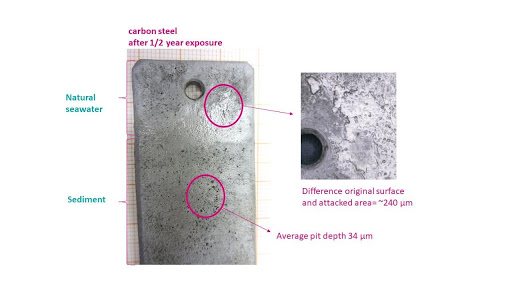

Visual inspection of blank steel coupons after 6 months of incubation revealed rusty-brown corrosion products and tubercles in the area which was exposed to seawater whereas the area which was exposed to the sediment showed blackish brown corrosion products.
The zinc-coated coupons (with and without scratch) showed white precipitations at the water-sediment interface and in the area which was exposed to the sediment.
Only the corrosion products of the blank steel coupon showed presence of MIC relevant microorganisms: sulfate-reducing bacteria (SRB), acid-producing bacteria (APB) and iron-reducing bacteria (IRB). SEM-EDX analysis showed presence of Fe, O, which explains the rusty-brown color of iron(III)oxides and S was detectable which forms with Fe the black precipitations, iron sulfide (FeS).
Blank steel coupons showed a corrosion rate of 0.06 mm/year and pitting was found. The average pit depth was 34 µm on part of the coupon exposed to sediment and 240 µm on the water-sediment interphase. Presence of MIC relevant microorganisms, sulfur in the corrosion products and pitting corrosion is an indication that MIC is present and active on the coupon surface, especially in the water-sediment interphase.
